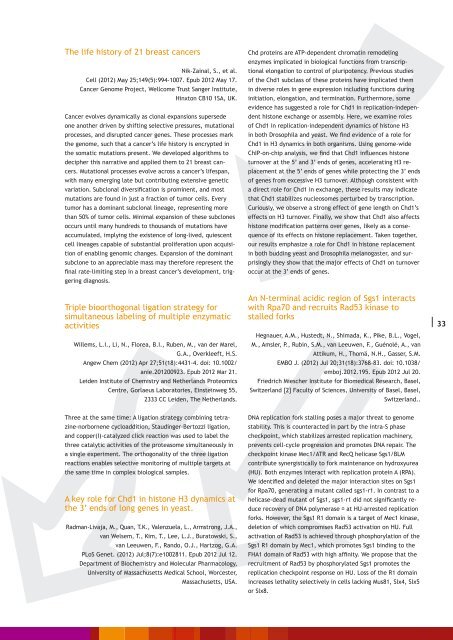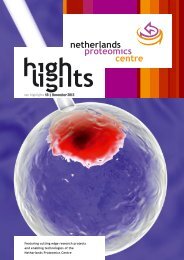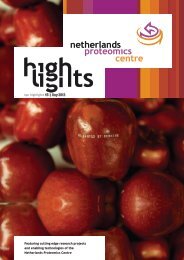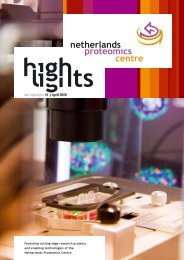NPC Valorisation Voucher - Netherlands Proteomics Centre
NPC Valorisation Voucher - Netherlands Proteomics Centre
NPC Valorisation Voucher - Netherlands Proteomics Centre
Create successful ePaper yourself
Turn your PDF publications into a flip-book with our unique Google optimized e-Paper software.
The life history of 21 breast cancersNik-Zainal, S., et al.Cell (2012) May 25;149(5):994-1007. Epub 2012 May 17.Cancer Genome Project, Wellcome Trust Sanger Institute,Hinxton CB10 1SA, UK.Cancer evolves dynamically as clonal expansions supersedeone another driven by shifting selective pressures, mutationalprocesses, and disrupted cancer genes. These processes markthe genome, such that a cancer’s life history is encrypted inthe somatic mutations present. We developed algorithms todecipher this narrative and applied them to 21 breast cancers.Mutational processes evolve across a cancer’s lifespan,with many emerging late but contributing extensive geneticvariation. Subclonal diversification is prominent, and mostmutations are found in just a fraction of tumor cells. Everytumor has a dominant subclonal lineage, representing morethan 50% of tumor cells. Minimal expansion of these subclonesoccurs until many hundreds to thousands of mutations haveaccumulated, implying the existence of long-lived, quiescentcell lineages capable of substantial proliferation upon acquisitionof enabling genomic changes. Expansion of the dominantsubclone to an appreciable mass may therefore represent thefinal rate-limiting step in a breast cancer’s development, triggeringdiagnosis.Triple bioorthogonal ligation strategy forsimultaneous labeling of multiple enzymaticactivitiesWillems, L.I., Li, N., Florea, B.I., Ruben, M., van der Marel,G.A., Overkleeft, H.S.Angew Chem (2012) Apr 27;51(18):4431-4. doi: 10.1002/anie.201200923. Epub 2012 Mar 21.Leiden Institute of Chemistry and <strong>Netherlands</strong> <strong>Proteomics</strong><strong>Centre</strong>, Gorlaeus Laboratories, Einsteinweg 55,2333 CC Leiden, The <strong>Netherlands</strong>.Chd proteins are ATP-dependent chromatin remodelingenzymes implicated in biological functions from transcriptionalelongation to control of pluripotency. Previous studiesof the Chd1 subclass of these proteins have implicated themin diverse roles in gene expression including functions duringinitiation, elongation, and termination. Furthermore, someevidence has suggested a role for Chd1 in replication-independenthistone exchange or assembly. Here, we examine rolesof Chd1 in replication-independent dynamics of histone H3in both Drosophila and yeast. We find evidence of a role forChd1 in H3 dynamics in both organisms. Using genome-wideChIP-on-chip analysis, we find that Chd1 influences histoneturnover at the 5’ and 3’ ends of genes, accelerating H3 replacementat the 5’ ends of genes while protecting the 3’ endsof genes from excessive H3 turnover. Although consistent witha direct role for Chd1 in exchange, these results may indicatethat Chd1 stabilizes nucleosomes perturbed by transcription.Curiously, we observe a strong effect of gene length on Chd1’seffects on H3 turnover. Finally, we show that Chd1 also affectshistone modification patterns over genes, likely as a consequenceof its effects on histone replacement. Taken together,our results emphasize a role for Chd1 in histone replacementin both budding yeast and Drosophila melanogaster, and surprisinglythey show that the major effects of Chd1 on turnoveroccur at the 3’ ends of genes.An N-terminal acidic region of Sgs1 interactswith Rpa70 and recruits Rad53 kinase tostalled forksHegnauer, A.M., Hustedt, N., Shimada, K., Pike, B.L., Vogel,M., Amsler, P., Rubin, S.M., van Leeuwen, F., Guénolé, A., vanAttikum, H., Thomä, N.H., Gasser, S.M.EMBO J. (2012) Jul 20;31(18):3768-83. doi: 10.1038/emboj.2012.195. Epub 2012 Jul 20.Friedrich Miescher Institute for Biomedical Research, Basel,Switzerland [2] Faculty of Sciences, University of Basel, Basel,Switzerland..| 33Three at the same time: A ligation strategy combining tetrazine-norbornenecycloaddition, Staudinger-Bertozzi ligation,and copper(I)-catalyzed click reaction was used to label thethree catalytic activities of the proteasome simultaneously ina single experiment. The orthogonality of the three ligationreactions enables selective monitoring of multiple targets atthe same time in complex biological samples.A key role for Chd1 in histone H3 dynamics atthe 3’ ends of long genes in yeast.Radman-Livaja, M., Quan, T.K., Valenzuela, L., Armstrong, J.A.,van Welsem, T., Kim, T., Lee, L.J., Buratowski, S.,van Leeuwen, F., Rando, O.J., Hartzog, G.A.PLoS Genet. (2012) Jul;8(7):e1002811. Epub 2012 Jul 12.Department of Biochemistry and Molecular Pharmacology,University of Massachusetts Medical School, Worcester,Massachusetts, USA.DNA replication fork stalling poses a major threat to genomestability. This is counteracted in part by the intra-S phasecheckpoint, which stabilizes arrested replication machinery,prevents cell-cycle progression and promotes DNA repair. Thecheckpoint kinase Mec1/ATR and RecQ helicase Sgs1/BLMcontribute synergistically to fork maintenance on hydroxyurea(HU). Both enzymes interact with replication protein A (RPA).We identified and deleted the major interaction sites on Sgs1for Rpa70, generating a mutant called sgs1-r1. In contrast to ahelicase-dead mutant of Sgs1, sgs1-r1 did not significantly reducerecovery of DNA polymerase α at HU-arrested replicationforks. However, the Sgs1 R1 domain is a target of Mec1 kinase,deletion of which compromises Rad53 activation on HU. Fullactivation of Rad53 is achieved through phosphorylation of theSgs1 R1 domain by Mec1, which promotes Sgs1 binding to theFHA1 domain of Rad53 with high affinity. We propose that therecruitment of Rad53 by phosphorylated Sgs1 promotes thereplication checkpoint response on HU. Loss of the R1 domainincreases lethality selectively in cells lacking Mus81, Slx4, Slx5or Slx8.






